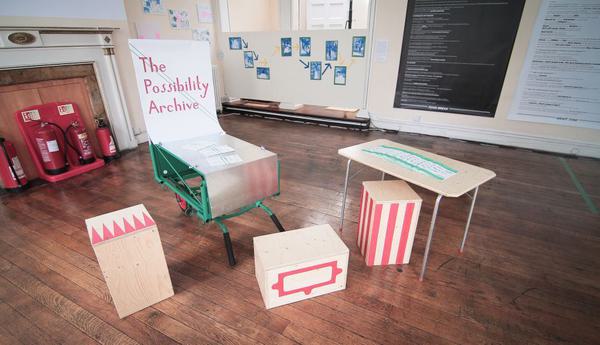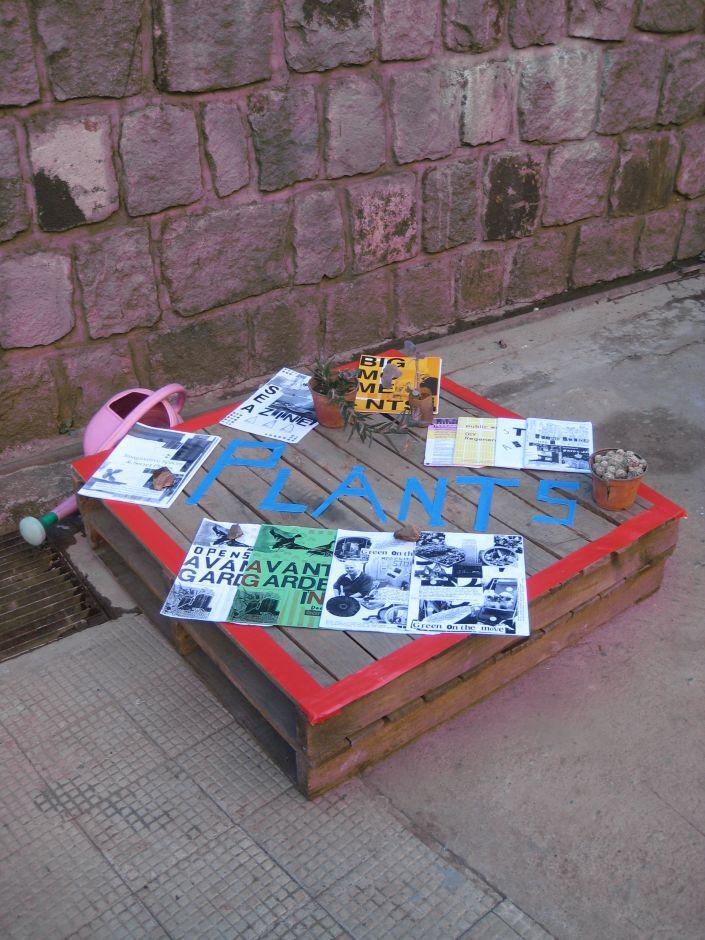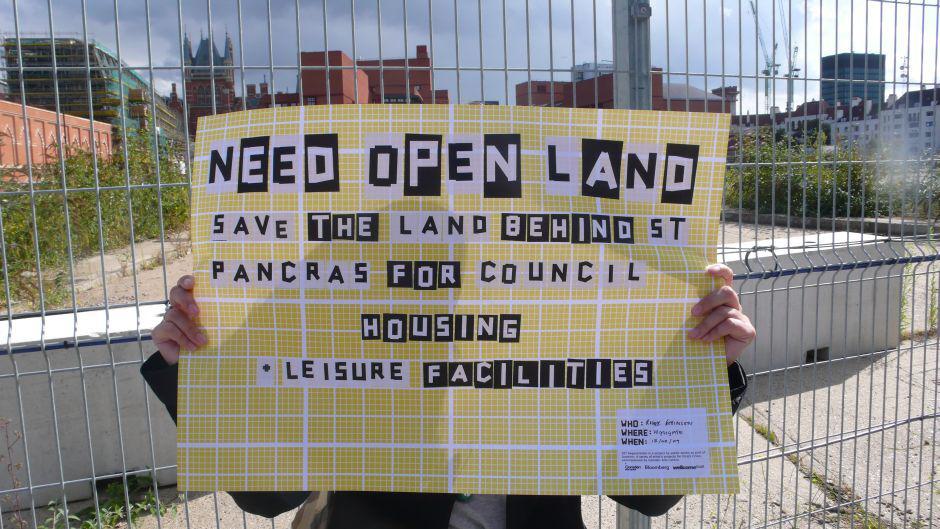Polly Brannan selected by Sepake Angiama (2012)

Polly Brannan, Possibility Archive, 2012. Found objects, wood, metal, print, paper
Sepake Angiama profiles the work of artist and education curator, Polly Brannan, which encompasses research, installation, events and fanzine publishing.
Polly Brannan’s practice focuses on human interaction within transient spaces. She occupies residential or corporate spaces that people might pass through on a daily basis without noticing, or spaces that act as an axis point between divergent communities.
Through creating participative interventions, Brannan’s work often employs an architectural interface such as a mobile unit that can be transformed into a stage for performance, a space to congregate, or simply a community notice board. Her mode of production is dialogue, registering a dialogue between people and place. For Brannan conversations are an informal method of exchange that the artist uses as a tool to develop her projects.
Brannan often fixes herself to one location to become familiarised with the communities and individuals that engage with that particular space. By communicating with different sections of society over long periods, she invites people to share their personal histories and stories relating to a setting. Brannan’s skill lies in finding a point of interest to slow people down long enough to begin a conversation.

Polly Brannan, Avant Gardening Shi Semania, 2011
A selection of self-published fanzines
Brannan has developed her practice over the past decade, initially within the public gallery sector and through being part of the artist and architecture collective publicworks. In 2009 Brannan set up Avant Gardening with Paul Green; collaboratively they deal with issues of regeneration, environment and sustainability through devising workshops around gardening, food and art. Committed to a dialogic practice that cannot be quantified through the evaluation of an art object or end product, Brannan often produces fanzines with the individuals and groups that she encounters. However these fanzines only act as a form of documentation of the dialogue that has unfolded between the artist, public and space.
Projects require extended periods of time to form relationships with people whose contribution resides in the experience of living and working in a particular setting. Many projects have developed under the rubric of being socially engaged, a practice with a long and well-established history which has developed from an earlier notion of ‘community arts’ and politicised action that has since informed the basis of ‘gallery education’ in the UK.

Polly Brannan, DIY REGENERATION, public works, 2009
Milk float, posters
Some may feel that this type of practice does not require the same level of critical attention as an artist who makes desirable objects for the commercial market or for the ‘white cube’. However Brannan approaches each project with critical foresight thinking about how to create an alternative relationship to a place or setting that we consider to be an already familiar part of our everyday lives. Her mode of production often means that the gallery context is not necessarily where the ‘work’ resides and can only provide a space to display the ephemeral remnants and documentation of her work or anecdotal evidence of her practice.
Though it is often driven by the needs of local authorities and public galleries to engage with a wider public or to attract funding to work with ostracised, socially excluded or notionally hard-to-reach groups, Polly Brannan's practice recognises the value in a human exchange between individuals and the spaces they occupy.
Sepake Angiama, 2012
About Polly Brannan
Since graduating with a BA Fine Art in 2003, Polly Brannan has produced exhibitions, talks, programmes, happenings, workshops and interventions at venues including the Serpentine Gallery, London; the Barbican, London; Liverpool Biennial; Lisbon Experimenta Festival; Turner Contemporary, Margate; Tate Britain, London; Studio Voltaire, London and City of London Festival.
Commissions include Space Studios, London; Stanley Picker Gallery, London; the Delfina Foundation, London and Camden Arts Centre, London. In 2011 she was awarded an artist fellowship in Ethiopia through Gasworks Gallery/Triangle Trust, funded by Arts Council England, and was an artist in residence at the Centre for Possible Studios, Serpentine Gallery, London with designer Jackson Lam and resident artist at MKGallery, Milton Keynes during October.
Polly also produces self-published fanzines which are distributed throughout London. A selection have been published in the book Fanzines by Teal Triggs (Thames & Hudson, 2010) and are currently in an exhibition and touring library with Salford Zine Library, a self-publishing archive formed in January 2010.
She lives and works in London and has a studio at the Bootstrap Company in Dalston.
About Sepake Angiama
Sepake Angiama's interest lies in discursive practices and the social framework, which has led her to work with artists who disrupt or provoke aspects of the social sphere through action, design, dance and architecture.
Her projects include What can we achieve together? (2009-2012), A series of performative interventions, actions and projects that explore cooperative strategies including Centre for Cooperative Living (2010), a communal moestuin (vegetable garden) on a private balcony to investigate the question ‘What can you achieve by getting to know your neighbour?’, A Space Between (2011) and collaborative project [...] at the PUBLIC SCHOOL Brussels (2010), addressing alternative possibilities for the dissemination and distribution of ideas through a process of commissioning artworks and Drawn to Dance (2005) a choreographed intervention at Hayward Gallery. At the Royal College of Art she co-organised the Office of Real Time Activity, a parasitical organisation investigating the notion of institutional time. Other exhibitions and projects include, We Are Technology(2008) Pauza Gallery in Karkow,; The House that Herman Built (2008); Remember a Future Past (2007), Royal College of Art.
From 2004-7 she was Public Programmes Coordinator at Hayward Gallery. In 2008, she received the Monique Beudert Award. She currently runs Fräulein, a series of performative dinners and projects with artist George Henry Longly originating from her home in Margate and is the Curator of Public Programmes at Turner Contemporary.
These biographies were written in (2012) as part of the Open Frequency programme. For the most current information, please visit:
Open Frequency (2004–2014)
This profile was part of Open Frequency, an Axis programme that highlighted emerging developments in contemporary art practice across the UK. Artists were selected and profiled by leading curators, artists, and writers, offering unique insights into the practices shaping contemporary art at the time. These archives remain a valuable resource for understanding the trajectory of some of the most exciting artists of the period.
Helping Artists Keep Going
Axis is an artist-led charity supporting contemporary visual artists with resources, connection, and visibility.


